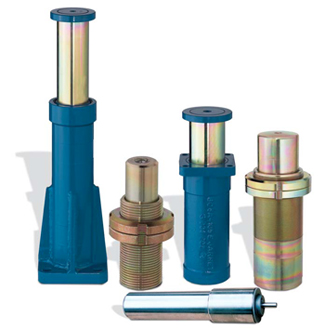Experts at deciphering obscure technical labels, ENKOSI veterans are pulling out all the stops today. In this brief outline, Jarret Springs are going under the spotlight. They’re tasked with an important duty that of supporting a heavy rolling load, even if that load carries great vibrational energies. Employed as work rock chock separation devices, let’s get this guide moving.
Visco-Dampening Jarret Springs
Unlike coiled mechanical springs, these visco-elastic devices employ silicone compounds. Their work roll chock separation functions take the devices into mines and mills, places that use large mechanical frames filled with moving materials. With the sealed silicone reservoir operating, the spring gains a locking feature that simply cannot be matched by a regular set of coil springs. They can perform as vibration dampeners or as energy stores, with their essential force retention properties locked inside a near parts-free mechanism profile. Furthermore, employing that visco-elastic feature, the devices require little maintenance.
Equipped with Pre-stressed Energy Storage Features
Conventional mechanical dampeners absorb energy, and they store that energy while the spring is static. Jarret Springs are more versatile. Acting as hydraulic jacks in mills and mines, the easy-installation devices vary their energy storing profiles when the silicone chamber’s geometry alters. Two per chock, the pre-stressed pistons prevent compressive motion as soon as they’re installed. Adjusted so that they accommodate a given space, the energy stored inside the silicone reservoir assure roller separation, even when the rolls require changing. And, thanks to that pre-stressing feature, there’s no need to jack up the work rolls when the time comes to adjust their separation intervals.
A Feature-rich and Versatile Product
Compact and loaded with fluid strength, Jarret Springs serve their purpose very well indeed. Onto some of their key design specifications, we start with temperature limitations. Compressive forces incur heat losses when visco-elastic materials are loaded. Safe to utilise when the operational temperature inside a mill is between -40° C and +70° C, this absolute limit accumulates less device stress if the thermal limits drop to a more accommodating -20° C to +50° C. Then there’s the seals, guide rings, and reservoir geometry to select. Lastly, choose a zinc-plated or hard-chrome protected material base, a coating that’ll endure.
Coatings choices are dictated by the environment and the application, which could be a hot or cold strip mill, a tin mill, a mining facility, or some other equipment setting that’ll benefit from groups of pre-stressed, visco-elastic chock separation devices, as employed in a work rock processing environment. Compact, maintenance free, and capable of functioning optimally after years of inactivity, Jarret Springs adapt to dampen or store massive amounts of energy within countless industrially challenging settings.
For more information, download the Jarret Spring catalogue, visit our Enidine page or contact us.


